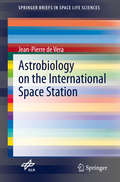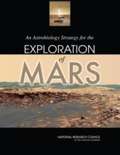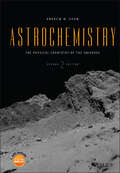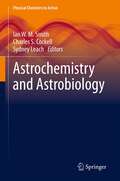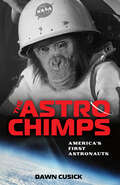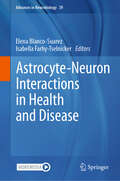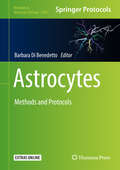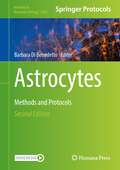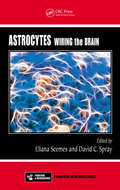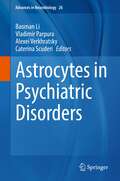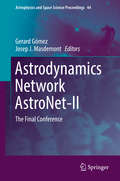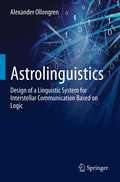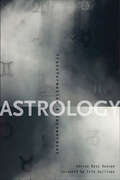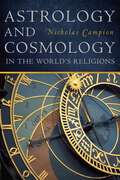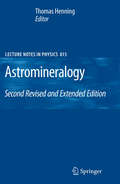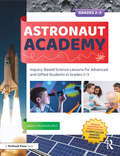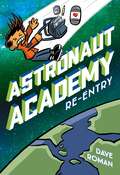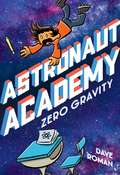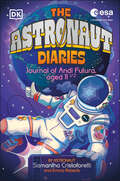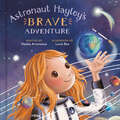- Table View
- List View
Astrobiology on the International Space Station (SpringerBriefs in Space Life Sciences)
by Jean-Pierre de VeraThis volume on astrobiology of the Springer Briefs in Life Sciences book series addresses the three fundamental questions on origin, evolution, distribution and future of life in the universe: how does life begin and evolve? Is there life beyond Earth and, if so, how can we detect it? What is the future of life on Earth and in the universe? The book provides insights into astrobiological experiments that are being performed on the International Space Station, ISS, and discusses their findings.This extremely exciting volume on astrobiology is intended for scientists of various research fields and for laypersons interested in space research and in the fundamental issues of the universe and life.
An Astrobiology Strategy for the EXPLORATION of MARS
by National Research Council of the National AcademiesThree recent developments have greatly increased interest in the search for life on Mars. The first is new information about the Martian environment including evidence of a watery past and the possibility of atmospheric methane. The second is the possibility of microbial viability on Mars. Finally, the Vision for Space Exploration initiative included an explicit directive to search for the evidence of life on Mars. These scientific and political developments led NASA to request the NRC’s assistance in formulating an up-to-date integrated astrobiology strategy for Mars exploration. Among other topics, this report presents a review of current knowledge about possible life on Mars; an astrobiological assessment of current Mars missions; a review of Mars-mission planetary protection; and findings and recommendations. The report notes that the greatest increase in understanding of Mars will come from the collection and return to Earth of a well-chosen suite of Martian surface materials.
Astrochemistry: The Physical Chemistry of the Universe
by Andrew M. ShawA fully revised new edition of an introductory text to the dynamic and fascinating subject of astrochemistry Since the first edition in 2006 of Astrochemistry, the Mars rovers have driven 31.18 miles, there has been fly-by of Pluto changing it from a 4-pixel world on the Hubble Space Telescope into a mysterious non-planet. There have been visits to asteroids, revisiting Mercury, discovery of the Higgs Boson, discovery of over 2000 extrasolar planets and landing on the comet 67P/Churyumov–Gerasimenko by Rosetta mission – hence the timely publication of this new edition. This core textbook now includes more detailed information on the kinetic modelling of chemistry in the interstellar medium, extending the same principles of physical chemistry to meteor ablation and finally atmospheres and oceans. The increase in density from near-emptiness to 1.35 × 1021 L of water in the world’s oceans is used to take single collision kinetics into ensemble thermodynamics. A new introduction of thermodynamic using meteor ablation replaces traditional bomb calorimetry and per-biotic chemistry leads to spontaneous reactions. New to the second edition: An extended discussion on matter, dark or otherwise, interstellar and stellar chemistry and the origin of pre-biotic molecules Detailed chemical kinetic models for mechanisms of chemistry in the interstellar medium Origins of life in solution, enzyme kinetics and catalysis A review of Mars and Titan as habitats for life Fully referenced throughout to reflect the research frontier An introduction to the idea of analytical mathematical engines that can do all of the heavy mathematics and fostering the skill of setting up a model and testing it 200 problems with detailed solutions Written for undergraduate and postgraduate students in astrochemistry or more generally physical chemistry, the new edition of Astrochemistry is an important introductory text to the topic, the latest developments in the field and the
Astrochemistry and Astrobiology (Physical Chemistry in Action)
by Charles S. Cockell Ian W. Smith Sydney LeachAstrochemistry and Astrobiology is the debut volume in the new series Physical Chemistry in Action. Aimed at both the novice and experienced researcher, this volume outlines the physico-chemical principles which underpin our attempts to understand astrochemistry and predict astrobiology. An introductory chapter includes fundamental aspects of physical chemistry required for understanding the field. Eight further chapters address specific topics, encompassing basic theory and models, up-to-date research and an outlook on future work. The last chapter examines each of the topics again but addressed from a different angle. Written and edited by international experts, this text is accessible for those entering the field of astrochemistry and astrobiology, while it still remains interesting for more experienced researchers.
The Astrochimps: America's First Astronauts
by Dawn CusickMeet Ham, Minnie, Enos, Roscoe, Tiger, and Rocky. When the United States was scrambling to catch up to the Soviets after their successful launch of Sputnik, they didn't turn to Mercury Seven astronauts Alan Shepard and John Glenn. Rather, they began bringing chimpanzees to Holloman Air Force Base in New Mexico for a top-secret program. The goal? To do everything America needed to make space travel safe for humans and beat the Soviets. Based on extensive research and interviews with living members of the team of veterinarians, handlers, and psychologists who worked with the animals, The Astrochimps offers a fresh perspective on animal intelligence and the rise of the space age. Detailed back matter provides resources, space mission stats, and calls to action for young readers to honor the astrochimps' legacy and advocate for the humane treatment of chimpanzees today.Vividly depicted at work, at play, in and out of spacecrafts, these chimps played an under-appreciated part in helping the United States win the Space Race.
Astrocyte-Neuron Interactions in Health and Disease (Advances in Neurobiology #39)
by Elena Blanco-Suarez Isabella Farhy-TselnickerThis new book extensively explores a range of topics related to astrocyte-neuron interactions under multiple conditions, in both health and disease. These include the types of interactions that occur during development and the establishment of neuronal circuits that underlie learning and memory formation in various animal models as well as humans. Furthermore, the book addresses topics on how these interactions go awry in disease and injury. In addition, the authors propose inspiring new avenues to explore therapeutic approaches using astrocytes as targets. A cadre of international experts presents a broad range of views on the state-of-the-art of astrocyte-neuron interactions.
Astrocytes: Methods and Protocols (Methods in Molecular Biology #1938)
by Barbara Di BenedettoThis detailed volume gathers together a broad variety of methods essential to the investigation of the biology of astrocytes and their multifaceted roles in both healthy and diseased brains. Beginning with some overviews of the subject, the book continues by covering techniques for the isolation of astrocytes from animal models, the investigation of astrocyte morphology and function, as well as for understanding astrocyte pathologies in the central nervous system. Written for the highly successful Methods in Molecular Biology series, chapters include introductions to their respective topics, lists of the necessary materials and reagents, step-by-step, readily reproducible laboratory protocols, and tips on troubleshooting and avoiding known pitfalls. Authoritative and practical, Astrocytes: Methods and Protocols serves as an ideal guide for both experienced and beginner scientists working toward unraveling the novel, fascinating roles of these versatile cells.
Astrocytes: Methods and Protocols (Methods in Molecular Biology #2896)
by Barbara Di BenedettoThis detailed volume gathers methods essential for investigating the multifaceted roles of astrocytes in both physiology and pathological conditions. The book covers several techniques for the preparation of astrocytes from animal models, the examination of astrocyte morphology and functions in vitro and ex vivo, as well as the investigation of astrocyte pathologies in the central nervous system. Written for the highly successful Methods in Molecular Biology series, chapters include introductions to their respective topics, lists of the necessary materials and reagents, step-by-step and readily reproducible laboratory protocols, and tips on troubleshooting and avoiding known pitfalls. Authoritative and practical, Astrocytes: Methods and Protocols, Second Edition serves as an ideal guide for both experienced and beginner scientists working toward unravelling the roles of these highly versatile cells.
Astrocytes: Wiring the Brain (Frontiers in Neuroscience)
by Eliana Scemes David C. SprayAstrocytes play diverse roles in central nervous system (CNS) function and dysfunction, and the connections that the astrocyte makes with other cells of the brain are essential for a variety of important neural tasks. Bringing together contributions from international experts at the top of their field, Astrocytes: Wiring the Brain emphasizes cellul
Astrocytes in (Patho)Physiology of the Nervous System
by Vladimir Parpura Philip G. HaydonThe goal of this book is to integrate information that has accumulated in recent years revealing the active role of astrocytes in physiological processing in the central nervous system and to use this as a basis for identifying pathological roles for these glial cells in the brain. Astrocytes, a subtype of glial cell, have long been neglected as active participants in intercellular communication and information processing in the central nervous system, in part due to their lack of the electrical excitability. However, astrocytes possess a diverse assortment of ion channels, neurotransmitter receptors, and transport mechanisms that enable astrocytes to respond to many of the same signals that act on neurons. Since astrocytes can detect chemical transmitters that are released from neurons and can release extracellular signals, there is an increasing awareness that they play physiological roles in regulating neuronal activity and synaptic transmission. Astrocytes also play critical roles during pathophysiological states of the nervous system.
Astrocytes in Psychiatric Disorders (Advances in Neurobiology #26)
by Baoman Li Vladimir Parpura Alexei Verkhratsky Caterina ScuderiThis contributed volume discusses the multiple roles of astrocytes, which determine the progression and outcome of neuropsychiatric diseases. This emerging area of study examines the ways in which astrocytes are involved in various aspects of disease initiation, progression and resolution. This monograph aims to integrate the body of information that has accumulated in recent years revealing the active role of astrocytes in neuropsychiatric pathology and in psychiatric disorders. Understanding roles of astrocytes in pathology will provide new targets for medical intervention and aid the development of much needed therapeutics. This book will be valuable for researchers and workers in the fields of neurobiology, neurology, and psychiatry, as well as fill the need for a textbook used in advanced courses/graduate seminars in glial pathophysiology.
Astrodynamics Network AstroNet-II: The Final Conference (Astrophysics and Space Science Proceedings #44)
by Gerard Gómez Josep J. MasdemontThese are the proceedings of the "AstroNet-II International Final Conference". This conference was one of the last milestones of the Marie-Curie Research Training Network on Astrodynamics "AstroNet-II", that has been funded by the European Commission under the Seventh Framework Programme. The aim of the conference, and thus this book, is to communicate work on astrodynamics problems to an international and specialised audience. The results are presented by both members of the network and invited specialists. The topics include: trajectory design and control, attitude control, structural flexibility of spacecraft and formation flying. The book addresses a readership across the traditional boundaries between mathematics, engineering and industry by offering an interdisciplinary and multisectorial overview of the field.
Astrolinguistics: Design of a Linguistic System for Interstellar Communication Based on Logic
by Alexander OllongrenIn linguistics, one of the main areas of modern research involves the capabilities and possibilities of there being a "lingua cosmica," a LINCOS, a universal language that could be used to communicate with non-human intelligences. This book touches on the area of the development and use of a "lingua universalis" for interstellar communication, but it also presents concepts that cover a broad area of linguistics. Chomsky's paradigm on universal properties of natural languages, for a long time a leading general theory of natural languages, includes the strong assumption that humans are born with some kind of universals stored in their brains. Are there universals of this kind of language used by intelligent beings and societies elsewhere in the universe? We do not know whether such languages exist. It seems to be impossible to determine, simply because the universe is too large for an exhaustive search. Even verification will be hard to obtain, without quite a bit of luck. This book uses astrolinguistic principles in message construction and is helpful in clarifying and giving perspective to discussions on existential questions such as these.
Astrology: Transformation & Empowerment
by Adrian Ross DuncanA guide to the practice of astrology, for students, novice astrologers and therapists interested in providing counseling and readings.Astrology ascribes meaning to planetary events and assumes that the energy that moves the universe has a kind of inherent intelligence. The astrologer maintains that there is a natural resonance between the evolving motion of the universe, and the development of the human soul. For the first time, Adrian Duncan shows how to empower clients and create transformation by harnessing horoscopes.Duncan has created an innovative manual that masterfully guides astrological practitioners and interpreters through every aspect of working with clients. Going beyond astrology simply as a diagnostic tool, Astrology: Transformation & Empowerment shows how to harness perception and sensory states to create positive change in one interpretive session.Part 1 “Setting the Scene,” explains how to read the client before reading their chart. Body language, mind reading, and the elements are touched upon.Part 2 “The Major Players,” depicts specific planetary combinations and what they entail in regard to emotional responses, relationships, and the future.Part 3 “Transformation Methods,” teaches ways to expand awareness of the problem at hand, reframe the reading, expand sensory skills, and discover new communications systems. Throughout, Duncan shares profiles and vignettes of clients that demonstrate his techniques.
Astrology and Cosmology in Early China
by David W. PankenierThe ancient Chinese were profoundly influenced by the Sun, Moon and stars, making persistent efforts to mirror astral phenomena in shaping their civilization. In this pioneering text, David W. Pankenier introduces readers to a seriously understudied field, illustrating how astronomy shaped the culture of China from the very beginning and how it influenced areas as disparate as art, architecture, calendrical science, myth, technology, and political and military decision-making. As elsewhere in the ancient world, there was no positive distinction between astronomy and astrology in ancient China, and so astrology, or more precisely, astral omenology, is a principal focus of the book. Drawing on a broad range of sources, including archaeological discoveries, classical texts, inscriptions and paleography, this thought-provoking book documents the role of astronomical phenomena in the development of the 'Celestial Empire' from the late Neolithic through the late imperial period.
Astrology and Cosmology in the World’s Religions
by Nicholas Campion&“An ambitious examination of cosmologies and astrologies from around the world. The diversity of cultures Campion includes is impressive.&” —Jacqueline Feke, History of Astronomy When you think of astrology, you may think of the horoscope section in your local paper, or of Nancy Reagan&’s consultations with an astrologer in the White House in the 1980s. Yet almost every religion uses some form of astrology: some way of thinking about the sun, moon, stars, and planets and how they hold significance for human lives on earth.Astrology and Cosmology in the World&’s Religions offers an accessible overview of the astrologies of the world&’s religions, placing them into context within theories of how the wider universe came into being and operates. Campion traces beliefs about the heavens among peoples ranging from ancient Egypt and China, to Australia and Polynesia, and India and the Islamic world. Addressing each religion in a separate chapter, Campion outlines how, by observing the celestial bodies, people have engaged with the divine, managed the future, and attempted to understand events here on earth. This fascinating text offers a unique way to delve into comparative religions and will also appeal to those intrigued by New Age topics. &“Unlike most students of astrology, Campion transcends the limitations of Western tradition to examine the nature and roles of astrological and cosmological concepts in cultures from all continents. His examples provide original insights into how cosmologies shape these cultures&’ artistic, intellectual, and religious activities.&” —Stephen McCluskey, West Virginia University
Astrometry for Astrophysics: Methods, Models, and Applications
by William F. Van AltenaThe field of astrometry, the precise measurement of the positions, distances and motions of astronomical objects, has been revolutionized in recent years. As we enter the high-precision era, it will play an increasingly important role in all areas of astronomy, astrophysics and cosmology. This edited text starts by looking at the opportunities and challenges facing astrometry in the twenty-first century, from space and ground. The new formalisms of relativity required to take advantage of micro-arcsecond astrometry are then discussed, before the reader is guided through the basic methods required to transform our observations from detected photons to the celestial sphere. The final section of the text shows how a variety of astronomical problems can be solved using astrometric methods. Bringing together work from a broad range of experts in the field, this is the most complete textbook on observational astrometry and is ideal for graduate students and researchers alike.
Astromineralogy (Lecture Notes in Physics #815)
by Thomas HenningAstromineralogy deals with the science of gathering mineralogical information from the astronomical spectroscopy of asteroids, comets and dust in the circumstellar environments in general. This field has received a tremendous boost with the reliable identification of minerals by the Infrared Space Observatory. The first edition of this book, published in 2003, was the first comprehensive and coherent account of this exciting field. Data obtained in the meantime with the Spitzer Infrared Space Telescope, the stardust mission to the comet 81P / Wild 2, and with the Cassini mission, together with progress in ground-based observations and laboratory astrophysics form the basis for this updated and widely extended second edition.Beyond addressing the specialist in the field, the book is intended as a high-level but readable introduction to astromineralogy for both the nonspecialist researcher and the advanced student.
Astronaut Academy: Inquiry-Based Science Lessons for Advanced and Gifted Students in Grades 2-3
by Jason S. McIntoshThe word "astronaut" comes from the Greek words meaning "star sailor," and that is exactly what students will become in Astronaut Academy. This 30-lesson interdisciplinary science unit: Is designed to teach high-ability second and third graders how to think like real-world astronauts. Requires students to explore the far regions of the solar system. Was designed using the research-based Integrated Curriculum Model. Features challenging problem-based learning tasks and engaging resources. Includes detailed teacher instructions and suggestions for differentiation. In this unit, students study the concept of exploration, journey to each planet, and create their own space station, all while acquiring scientific knowledge and habits, including how to follow the scientific method and properly conduct research and experiments. Suggestions and guidance are included on how teachers can adjust the rigor of learning tasks based on students' interests and needs. Grades 2-3 Recipient of the 2020 NAGC Curriculum Award
Astronaut Academy: Re-entry (Astronaut Academy #2)
by Dave RomanBeautifully updated with fresh color, this new edition Astronaut Academy: Re-Entry is the adventurous second volume of the middle-grade graphic novel series from Dave Roman.Hakata Soy still has a lot to learn!It’s a new semester at Astronaut Academy and everyone is excited for the Fireballchampionship—especially Hakata’s cranky roommate, Tak Offsky. But lurking in the shadows is a shape-shifting, heart-stealing monster, and it might just knock the Fireball team out of the competition!Can Hakata and Tak put aside their differences, lead the team to victory, and save the lives of their classmates?
Astronaut Academy: Splashdown (Astronaut Academy #3)
by Dave RomanAstronaut Academy: Splashdown is the exciting third installment of the middle grade graphic novel series from author Dave Roman.Heroes like Hakata Soy don’t take vacation!It’s summer vacation for the students of Astronaut Academy, and Maribelle Mellonbelly is throwing the best party ever on Beach Planet? Yes! But tensions heat up fast when Hakata Soy’s arch rival, Rick Raven, arrives. And soon the whole planet is heating up—with a giant volcano threatening to blow its top!Unless they can work together save the planet, the students of Astronaut Academy will betoast. But can they put aside their differences in time to turn the tides?
Astronaut Academy: Zero Gravity (Astronaut Academy #1)
by Dave RomanBeautifully updated with fresh color, this new edition Astronaut Academy: Zero Gravity is the first volume of the middle-grade graphic novel series from Dave Roman.Hakata Soy’s past won’t stay in the past!This former space hero is doing his best to keep his head down at Astronaut Academy. Things aren’t going so great, though. The most popular girl in school has it in for him. His best friend won’t return his calls. And his new roommate is a complete jock who only cares about Fireball.Hakata just wants to make a fresh start. But how will he find time to study Anti-GravityGymnastics and Tactical Randomness when he’s got a robot doppelganger on its way to kill him?
Astronaut Annie
by Suzanne Slade Nicole TadgellBrightly List: Best Children's Books of March 2018 Annie’s joyful exuberance and her family’s whole-hearted support leave no doubt that her dream is within her grasp. This delightful story—with backmatter about women astronauts—encourages young readers to pursue their dreams and reach for the stars. Career Day is approaching, and Annie can’t wait to show her family what she’s planning to be when she grows up. But, she must keep it a secret until Friday! So curious family members each ask Annie for a clue. Convinced that she’ll be a news reporter like he once was, Grandpop gives her his old camera and notebook to use for her presentation. Grandma is sure Annie wants to be a champion baker like her, so she offers a mixing bowl and oven mitts to Annie. Hopeful she'll become the mountain climber he aspired to be, Dad gives Annie an old backpack. Mom presents Annie with a pair of high-top sneakers to pursue Mom's favorite sport in high school -- basketball. Grateful for each gift, Annie cleverly finds a way to use them all to create her Career Day costume. When the big day arrives, Annie finally reveals her out-of-this-world dream to everyone. Fountas & Pinnell Level M Selected for the Red Tricycle Ultimate Summer Reading List! http://redtri.com/summer-reading-list-amazon-kids-edition-tablet/slide/1
The Astronaut Diaries
by Emma Roberts Samantha CristoforettiHow do astronauts prepare to go to space? Why are robots so important to space exploration? And how do you wash your hair in zero gravity?Andi Futura, her older brother and their parents are about to become the first family in space… and she’s sharing everything she learns while living aboard a space station with YOU!Discover what life in space is really like in this fascinating read authored by real-life astronaut Samantha Cristoforetti. Andi’s diary entries share the fun of slow cartwheeling around a space station and watching 16 sunrises and sunsets every day, while her reports to mission control will have you learning about how conducting science experiments in space can help humanity.Can Andi do enough to show that she’s capable of becoming a fully-fledged astronaut and commanding her own mission one day? Pull on your space helmet, strap on your oxygen tank, and dive into The Astronaut Diaries to find out!
Astronaut Hayley's Brave Adventure
by Hayley ArceneauxAn imaginative, inspiring, and beautifully illustrated picture book from the youngest American to ever orbit the earth—cancer survivor Hayley Arceneaux—who learned that if we are willing to be scared and brave at the same time, extraordinary things are possible.A fantastic fictional space story inspired by the author's real-life experiences, Astronaut Hayley&’s Brave Adventure is the perfect book for young readers who have big dreams and even bigger hearts.Like every child, Hayley has to learn to be brave in ordinary ways, like facing the first day of school or trying a new sport. But when Hayley gets sick—really sick—she has to learn to be brave in not-so-ordinary ways. When Hayley is invited to become an astronaut and travel to outer space, she knows she is up for the challenge. But she'll need all her courage to handle what's in store!Astronaut Hayley&’s Brave Adventure will inspire children everywhere to reach for the stars, to aspire for the impossible, and to seek new friends and new adventures wherever they are! The perfect choice for parents looking for:• Books about space• Inspiring story books• Role model books for girls and boys
